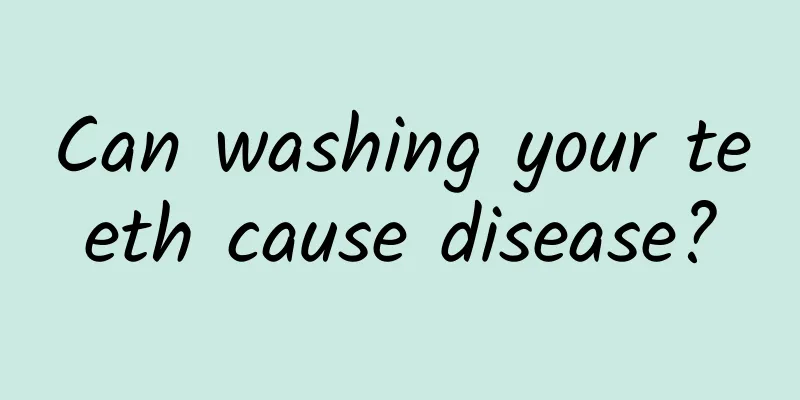Can washing your teeth cause disease?

|
This is the 3427th article of Da Yi Xiao Hu Recently, a piece of news about "infective endocarditis after teeth cleaning" swept the major media and sparked heated discussions among the public. People were shocked and asked: Is the risk of teeth cleaning really that great? If so, how can people prevent it? The risk of infection is not just endocarditis Teeth cleaning is a relatively simple routine operation in the oral diagnosis and treatment process, but the risk of infection it may cause cannot be underestimated. This is because: first, the oral cavity itself is a multi-bacterial environment; second, teeth cleaning instruments or equipment will frequently come into contact with saliva or blood, which is most likely to spread diseases; third, teeth cleaning will inevitably cause bleeding gums (please note: teeth cleaning is not the root cause of bleeding gums, but the ultrasonic vibration generated by the teeth cleaning instrument will definitely aggravate the symptoms of bleeding gums); finally, teeth cleaning will cause a large amount of spray containing pathogenic microorganisms to form. In fact, the infections that may be caused by teeth cleaning are also quite complicated. First, pathogens are complex. Pathogens are microorganisms that can cause infectious diseases in humans, animals, and plants. These microorganisms include not only bacteria, but also fungi, viruses, etc. The pathogen mentioned in the news is streptococcus, which belongs to the category of bacteria; while hepatitis B virus and HIV (scientific name: human immunodeficiency virus) may also infect patients through tooth washing, and they both belong to the category of viruses. Second, the route of infection is also very complicated These pathways can be summarized into two categories, namely, autoinfection and cross-infection. The so-called self-infection, also known as endogenous infection, refers to the infection caused by conditional pathogens colonized in the patient's own skin or cavity or colonized bacteria obtained from the outside due to changes in the number or colonization site; while cross-infection belongs to exogenous infection, which refers to the infection caused by direct or indirect transmission between patients and between patients and staff. Obviously, the case in the news belongs to the case of autoinfection, which is an infection caused by streptococci colonized in the mouth entering the circulatory system. But this is only one of the possible situations in which teeth washing causes infection. Cross-infection caused by non-standard teeth washing operations is likely to lead to more serious infections and thus more serious consequences. For example, non-standard teeth washing may spread hepatitis B and AIDS. To prevent infection, dentists have come up with many ways 01Before teeth cleaning 1) Inspection Before planning a dental cleaning, patients are usually given a health check-up, an important part of which is to confirm the status of infectious diseases. Patients with hepatitis B and AIDS are not suitable for dental cleaning. This is because, although there is no direct contact between patients, the spray composed of the patient's saliva, blood and the water mist sprayed by the dental cleaning machine during the dental cleaning process is likely to contaminate the clinic environment, thereby causing indirect transmission of pathogens (which can cause cross infection). Of course, dentists must also ensure that they do not have infectious diseases (which can cause cross infection). 2) Rinse your mouth Dentists usually ask patients to rinse their mouths before cleaning their teeth. This rinse is different from the usual rinse. The mouthwash used in this rinse must be an antibacterial mouthwash, such as 3% hydrogen peroxide solution, 0.12% chlorhexidine solution, etc., and it must be rinsed for 1 minute. Its main purpose is to reduce the number of pathogens in the spray formed during the cleaning process (which can cause cross infection) and prevent bacteremia (which can cause self-infection). 02 During teeth cleaning 1) Use protective gear The use of protective equipment and disposable or sterilized instruments is necessary to prevent infection. Patients usually need to wear eye masks or chest covers (must be worn), and doctors need to wear gloves, masks, goggles and masks. All of these measures help prevent cross infection. Protective masks 2) Use a saliva extractor During the teeth cleaning process, dentists will also use a saliva suction device. This measure can not only prevent the continuous production of saliva, blood and water mist from causing the patient to choke and cough, but also reduce the formation and free diffusion of spray, thereby reducing the possibility of spray spreading potential pathogens (causing cross-infection). Saliva suction device (strong suction type) In addition, the ultrasonic waves generated by the dental cleaning device itself also have a certain antibacterial effect. 03After teeth cleaning After the cleaning, your dentist will often wipe the area with a sterile cotton ball soaked in hydrogen peroxide. This procedure will further reduce the possibility of pathogens entering the circulation (which can cause autoinfection) and help stop bleeding. The key to safe teeth cleaning is standardized operation Although teeth cleaning is the simplest and most basic operation in oral diagnosis and treatment, in fact, in many medical institutions, teeth cleaning does not need to be done by doctors themselves. However, given the risk of spreading infectious diseases, its standardized operation is very important and necessary. And what ensures standardized operation is the standardized management of medical institutions. Patients should also treat the health examination requirements put forward by medical institutions with the right attitude. A medical institution that lacks standardized requirements may seem to make it easier for patients, but the risks are self-evident. Author: Shanghai Health and Health Development Research Center rich |
>>: What does the fiery red maple leaf symbolize? How do maple leaves perform photosynthesis?
Recommend
Eat less and live longer. Are there any rules for fasting?
Recently, Brother Rong seems to be particularly f...
Gynecological inflammation that women are prone to in spring
In spring, as the climate begins to warm up, bact...
Can I eat chicken bone grass during menstruation?
Menstruation is the thing that many women fear th...
What causes ovulation pain?
The problem of ovulation pain is a situation that...
Airway foreign body obstruction: An emergency guide to protect your breathing
Author: Chen Hui, head nurse of the First Affilia...
What to eat after 13 days of normal delivery
Natural childbirth is the best choice for pregnan...
Does a woman test positive mean she is pregnant?
In the early stages of pregnancy, many women will...
What are the causes of an immature cervix?
If the cervix is immature, it will affect the p...
What is the reason why the color of the female thigh root turns dark
Many women will experience changes in skin color ...
Causes of vulvar itching during menstruation
I believe that female friends are no strangers to...
Consequences for women with too many sexual partners
The problem of having too many sexual partners is...
What causes vaginal itching and moisture?
Vaginal itching and moisture is a relatively comm...
There are small buds on the labia
If there is a small granulation on the edge of th...
What is the reason for a prominent Adam's apple in women?
Under normal circumstances, women have a relative...
Why does a woman have back pain when she lies down?
Compared with men, women are more fragile, so the...









